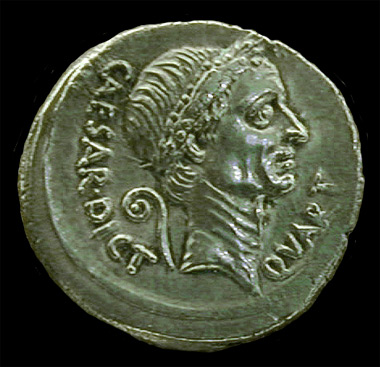
As dictator, Caesar continued to take every opportunity to remind Romans of his descent, both divine and royal, no doubt to justify his absolute rule. One medium, coinage, had long been used by prominent Roman officials to claim recognition for themselves and their family (see Roman Republican Coins). Caesar, however, was the first Roman to put his portrait on Roman coins during his lifetime. Generally regarded for their nominal value, coins also carried a message about economics and political power that was easily read by all, even the illiterate. While coins that were produced by mints at Rome tended to be more reserved in their iconography until the Principate, those produced in the Eastern provinces merely followed a long tradition of associating Hellenistic rulers with divinity.

The obverse of this silver denarius, minted by Julius Caesar at Rome in 44 BCE, is inscribed CAESAR DICT[ator] QUART[us] (Caesar Dictator for the 4th time); he was appointed in 49, 48, 46 for 10 years, and in 44 for life. It contains his wreathed head in profile, behind which is a symbol of the lituus, the sacred augural staff of the Pontifex Maximus, his guarantee of sacrosanctity, a position to which he was elected in 63 BCE and held until his death.

With the clear intent of being reappointed dictator for the second time, Caesar advertised his divine descent by placing the wreathed head of Venus Genetrix in profile on the obverse of this silver denarius (minted in Africa 47/46 BCE); the reverse contains the image of Aeneas carrying Anchises and holding the Palladium (Berlin, Pergamon Museum).
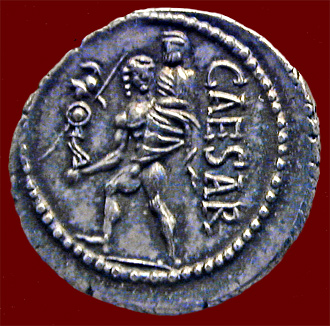
The reverse of a similar silver denarius of Caesar (minted 47/46 BCE) shows Aeneas leaving Troy, carrying Anchises on his left shoulder and holding in his right hand not Iulus but the Palladium, the statue of armed Athena from the city of Troy, which strongly resembles a Nike figure (Amsterdam, Allard Pierson Museum).
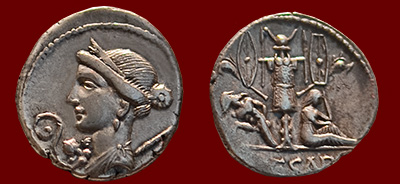
The obverse of a denarius of Caesar (Spanish mint, 46-45 BCE), shows the crowned head of Venus, in profile looking left; in front of her are a tiny Cupid and the lituus of the Pontifex Maximus. On the reverse is a tropaeum with a captured Gaul on one side and a mourning female symbolizing defeated Gallia on the other (Berlin, Pergamon Museum).
After Caesar's assassination Octavian, named in Caesar's will as his heir, was challenged to lay claim to his uncle's possessions and to his mantle of power.
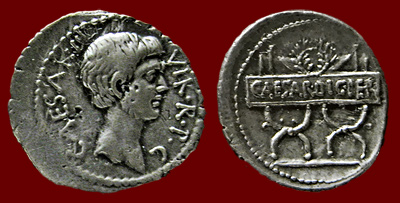
This silver denarius, minted by Octavian in 42 BCE, shows the head of Octavian on the obverse and Caesar's sella curulis, his imperial seat, on the reverse, together with his golden civic wreath and the inscription CAESAR DIC[tator] PER[petuus] (Berlin, Pergamon Museum).
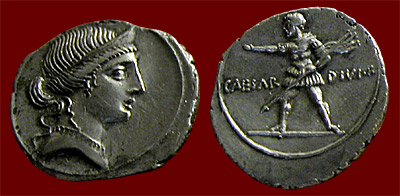
As the triumvirate fell apart, one of the strategies Octavian employed
was to imitate Caesar's iconography on coins, particularly his invocation of
Venus as the founder of the Iulii, and to lay claim to the name Caesar.
Sometime before the battle at Actium in 31 BCE, Octavian issued silver denarii
in several variations of the same theme, from different mints. The coins
contained on the obverse the crowned head of Venus (or a Venus-looking Pax). On
the reverse was a full-length portrait of Octavian, portrayed either as the
imperator-hero leading his troops into battle, or as the imperator in
adlocutio, inspiring his troops with his words; whatever the image, the
inscription taking on the name of Caesar was the same: Caesar divi
f[ilius] (Berlin, Pergamon Museum).
After the defeat of Antony Octavian
replaced Caesar's coin images with icons of his own: Venus gave way to the god
Apollo as the patron of Augustus.